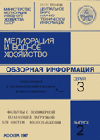UDC 63
CSCSTI 68.31
Russian Classification of Professions by Education 110000
Russian Library and Bibliographic Classification 40
Russian Trade and Bibliographic Classification 5607
BISAC TEC003000 Agriculture / General
It has been shown the role of carbon of dissolved organic matter (C DOM) in humus composition of irrigated chernozems as well as participation of humus substances proper in the formation of DOM. It has been found out that in chernozem long-term irrigated with weakly alkaline water the yield of C DOM is reliably higher than in nonirrigated soil when used even ordinary water extraction. It accounts for 53 and 40 mg l–1 respectively. It is attributed to the fact that because of influence of irrigative water the pH range became wider to some extent and alkalinity of soil medium became stronger and consequently the solubility of DOM increased. It has been noted that that the same tendency that is decrease is observed in depthwise distribution of humus and C DOM. As it should be expected, in irrigated soil processed with irrigative water the content of C DOM is somewhat higher (by 7–10 mg l–1) in the studied part of the profile as a whole. At the same time the relative role of C DOM in humus composition increases with increasing pH, up to 3 % of total organic soil carbon. It has been examined the interaction of irrigative water free of DOM with preparations of humus acids extracted from soil. Drown coloration of irrigative water is evidence of separation of DOM from humus acids. Moreover, the yield of C DOM proved to be three times higher in case of irrigative water than distilled one and accounted 120 and 350 mg l–1 respectively. This comparative experiment is an evidence of the fact that humus acids can be served as a source of DOM, especially in the event if more accessible organic matter is not available. Thus, long-term irrigation of chernozems in case of unsatisfactory application of organic fertilizers leads not only to biological and irrigational humus losses but also humus losses by way of transformation of humus acids into DOM
chernozem, irrigation, carbon, water-soluble organic matter of soils, irrigative water, humus losses
1. Fritz M., Opel T., Tanski G., Herzschuh U., Meyer H., Eulenburg A., Lantuit H. Dissolved organic carbon (DOC) in Arctic ground ice // The Criosphere, 2015. Vol. 9. P. 737-752.
2. Kaurichev I.S., Bazilinskaya M.V., Zabolotnova L.A. Qualitative composition of water-soluble organic matter extracted from humified and non-humified plant residues //Proc. of Timiryazev Agricultural Academy, 1972. No. 2. P. 101-109. (In Russian)
3. Jiang M.H., Zhong X.F., Yang L.M. Characteristic of dissolved organic matter in forest soils: influence of different plant covering // Proceedings of the 2015 International Forum on Energy, Environment Science and Materials (IFEESM 2015). P. 1201-1206.
4. Gonet S.S., Debska B. Dissolved organic carbon and dissolved nitrogen in soil under different fertilization treatments // Plant Soil Environ., 2006. Vol. 52. No 2. P. 55-63.
5. Zcolnay A., Gorlitz H. Water extractable organic matter in arable soils: Effect of drought and long-term fertilization // Soil Biol. Biochem., 1994. Vol. 26. P. 1257-1261.
6. Sharkov I.N., Samokhvalova L.M., Mishina P.V., Shepelev A.G. Influence of stubble residues on composition of organic matter of leached in the forest steppe of the Western Siberia // Soil Science (Pochvovedenie), 2014. No. 4. P. 473-479. (In Russian)
7. Yashin I.M. Water-soluble organic substances of soils of taiga zone and their environmental functions //Doctoral thesis of Sci. Biol. Moscow, 1993. 32 p. (In Russian)
8. Motuzova G.V., Zorina A.V., Stepanov A.A. Water-soluble organic substances of litters of Al-Fe podzols of Kola peninsula // Soil. Science, 2005. No. 1. P. 65-73. (In Russian)
9. Deb S.K. and Shukla M.K. A Review of Dissolved Organic Matter Transport Processes Affecting Soil and Environmental Quality // Journal of Environmental and Analytical Toxicology, 2011. Vol. 1. Issue 2. Doihttps://doi.org/10.4172/2161-0525.1000106.
10. Klenov B.M. Water-soluble organic constituent in irrigated chernozems of Near-Ob plateau // Land reclamation and water economy, 2017. No. 6. P. 40-43. (In Russian)
11. Zaitseva T.F. Acid and alkaline regime of forest steppe soils of Near-Ob plateau // Soil Science. 1995. No. 7. P. 830-839. (In Russian)
12. Neff J.C., Asner G.P. Dissolved organic carbon in terrestrial ecosystems: synthesis and a model // Ecosystems, 2001. No 4. P. 29-48.
13. Panin P.S., Tanasienko A.A. Irrigational erosion of chernozems and hydrochemistry of run off // Soil Science, 1989. No. 3. P. 113-122. (In Russian)
14. Orlov D.S., Grishina L.A. Laboratory work in humus chemistry. Moscow: Moscow University Publisher, 1981. 272 p. (In Russian)
15. Klenov B.M. Humus of irrigated leached chernozems of Near-Ob plateau // Land reclamation and water economy, 2016. No. 4. P. 32-35. (In Russian)
16. Shchedrin V.N., Dokuchaeva L.M., Yurkova R.Ye. Humus state of different soil types by long-term irrigation // Scientifif Journal of Russian Research Institute of Problems of Land Reclamation, 2017. No. 4(28). P. 1-19. (In Russian)
17. Shaporina N.A., Tanasienko A.A. Problems of irrigation of chernozems of Near-Ob area. Novosibirsk: Publishing House of Siberian Branch of RAS, 2014. 137 p. (In Russian)
18. Kononova M.M. Soil organic matter /M.M.Kononova. Moscow: Publising House of the USSR Academy of Sciences, 1963. 314 p. (In Russian)









